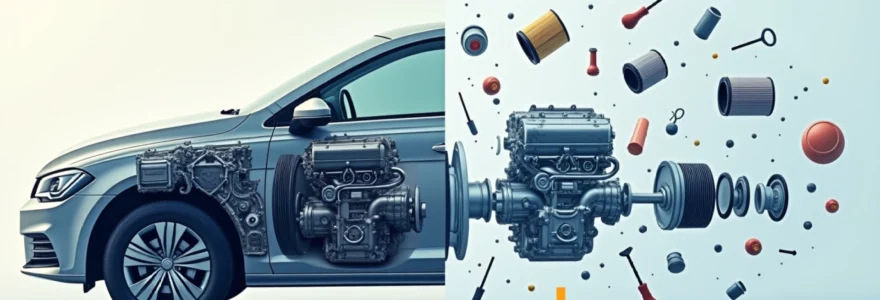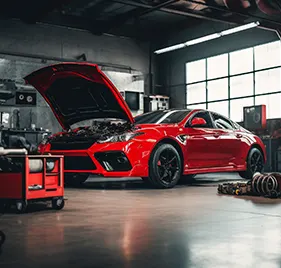Regular maintenance is crucial for keeping your vehicle running smoothly and efficiently. Two of the most important maintenance tasks are replacing your car's oil and air filters. These components play vital roles in protecting your engine and ensuring optimal performance. By learning how to replace them yourself, you can save money and gain a better understanding of your vehicle's inner workings.
Essential tools and materials for DIY oil and air filter replacement
Before diving into the replacement process, it's important to gather all the necessary tools and materials. Having everything on hand will make the job smoother and more efficient. Here's what you'll need:
- New oil filter (specific to your vehicle model)
- New air filter (specific to your vehicle model)
- Motor oil (check your owner's manual for the correct type and quantity)
- Oil filter wrench
- Socket set and ratchet
Additionally, you'll need a funnel, oil pan, gloves, and rags. It's also a good idea to have a torque wrench on hand to ensure proper tightening of components. Remember, using the correct tools is essential for a successful DIY maintenance job.
Step-by-step oil change procedure for modern vehicles
Changing your car's oil is a fundamental maintenance task that can significantly extend the life of your engine. While the specific steps may vary slightly depending on your vehicle model, the general process remains consistent across most modern cars.
Locating and accessing the oil drain plug
The first step in changing your oil is locating the drain plug. This is typically found on the bottom of the oil pan, underneath your vehicle. You may need to raise your car using a jack and secure it with jack stands to access this area safely. Once you've located the drain plug, place your oil pan beneath it to catch the old oil.
Using the appropriate socket or wrench, carefully loosen the drain plug. Be prepared for oil to start flowing immediately once the plug is removed. Allow the oil to drain completely, which may take several minutes.
Proper oil disposal and environmental considerations
It's crucial to dispose of used motor oil responsibly. Motor oil is a hazardous waste that can cause significant environmental damage if not handled properly. Never pour used oil down the drain or onto the ground. Instead, collect it in a sealed container and take it to a certified recycling center or auto parts store that accepts used oil.
Recycling used motor oil is not only environmentally responsible but also conserves a valuable resource. Just one gallon of used oil can be re-refined into 2.5 quarts of lubricating oil.
Selecting the correct oil grade and viscosity
Choosing the right oil for your vehicle is crucial for optimal engine performance and longevity. Your car's owner's manual will specify the recommended oil grade and viscosity. Common oil grades include 5W-30, 10W-30, and 5W-20. The first number indicates the oil's viscosity in cold temperatures, while the second number represents its viscosity at normal operating temperatures.
Using the wrong oil grade can lead to reduced fuel efficiency, increased engine wear, and potentially void your warranty. Always stick to the manufacturer's recommendations unless advised otherwise by a certified mechanic.
Torque specifications for oil drain plug and filter
Proper tightening of the oil drain plug and filter is crucial to prevent leaks and ensure a secure fit. Over-tightening can damage threads or crush gaskets, while under-tightening can lead to oil leaks. Use a torque wrench to achieve the correct tightness:
| Component | Typical Torque Range |
|---|---|
| Oil Drain Plug | 20-40 ft-lbs (27-54 Nm) |
| Oil Filter | 3/4 turn after gasket contact |
Always refer to your vehicle's service manual for the exact torque specifications, as they can vary between makes and models.
Air filter replacement techniques for various engine configurations
Replacing your car's air filter is another essential maintenance task that can improve engine performance and fuel efficiency. The process can vary depending on your vehicle's engine configuration, but the general principles remain the same.
Identifying air filter housing in different car models
The air filter housing is typically located near the front of the engine compartment. In most cars, it's a rectangular or cylindrical box made of plastic or metal. Some vehicles may have the air filter housed within the engine bay, while others might have it positioned behind the front grille.
To locate your air filter housing, consult your owner's manual or look for a large duct connected to the engine's intake system. Once you've found it, you'll usually need to unclip or unscrew the housing to access the filter.
Cleaning air filter housing and surrounding components
Before installing a new air filter, it's important to clean the housing and surrounding area. Use a clean, damp cloth to wipe away any dirt or debris from the housing. Pay special attention to the sealing surfaces where the filter sits, as any contamination here can compromise the filter's effectiveness.
For hard-to-reach areas, you can use compressed air to blow out dust and debris. However, be careful not to blow contaminants further into the engine's air intake system.
Choosing between OEM and aftermarket air filters
When selecting a new air filter, you have the choice between Original Equipment Manufacturer (OEM) filters and aftermarket options. OEM filters are made by your vehicle's manufacturer and are guaranteed to meet the original specifications. Aftermarket filters, on the other hand, are produced by third-party companies and may offer different features or price points.
While aftermarket filters can sometimes offer improved performance or longer life, it's essential to choose a reputable brand that meets or exceeds OEM specifications to ensure proper engine protection.
Consider factors such as filtration efficiency, airflow characteristics, and durability when making your choice. In most cases, sticking with OEM or high-quality aftermarket filters from recognized brands is the safest bet for maintaining your engine's health.
Common pitfalls and troubleshooting during DIY maintenance
While DIY maintenance can be rewarding, it's important to be aware of potential pitfalls. Here are some common issues you might encounter and how to address them:
- Cross-threading: When reinstalling the oil drain plug or filter, be careful not to cross-thread them. Start by hand to ensure proper alignment before using tools.
- Over-tightening: Use a torque wrench to avoid over-tightening components, which can lead to damage or difficult removal later.
- Oil spills: Have plenty of rags on hand and work carefully to minimize spills. Use a funnel when refilling oil to prevent messes.
If you encounter persistent issues or unusual noises after completing maintenance, it's best to consult a professional mechanic. Some problems may require specialized diagnostic tools or expertise to resolve safely.
Post-replacement checks and engine performance optimization
After replacing your oil and air filters, it's crucial to perform some final checks to ensure everything is working correctly and to optimize your engine's performance.
Resetting oil life monitors and service indicators
Many modern vehicles have electronic oil life monitoring systems that need to be reset after an oil change. The process for resetting these systems can vary by manufacturer, but it typically involves a series of steps using the vehicle's dashboard controls. Consult your owner's manual for the specific procedure for your car.
Failing to reset the oil life monitor can lead to premature service reminders or, worse, cause you to miss the next necessary oil change interval.
Proper break-in procedures for new filters
After installing new filters, it's important to follow proper break-in procedures to ensure optimal performance. For oil filters, start the engine and let it idle for a minute or two to allow oil to circulate through the new filter. Check for any leaks around the filter and drain plug.
For air filters, no specific break-in is typically required. However, you may notice a slight change in engine sound or performance as the new filter settles into place.
Monitoring oil pressure and air flow after replacement
In the days following your DIY maintenance, pay close attention to your vehicle's performance. Monitor the oil pressure gauge (if equipped) to ensure it's within normal range. Listen for any unusual engine noises that could indicate a problem with oil circulation.
For air filters, you might notice improved throttle response and potentially a slight increase in fuel efficiency. If you experience any negative changes in performance, such as reduced power or unusual noises, double-check your work or consult a professional.

